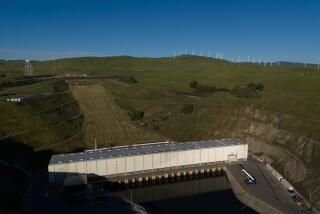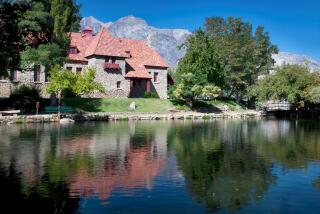TRIPS : FILLMORE FISH HATCHERY : Future Stock : State-operated hatchery offers visitors an up-close look at the development of rainbow trout.
- Share via
When your children ask, “‘Where do fish come from?” is your only answer, “The market”? If that’s the case, it may be time for a family outing to the Fillmore Fish Hatchery.
Located just east of town on the south side of California 126, the facility is one of 21 hatcheries operated by the state Department of Fish and Game. Although there are no formal tours, it is open to the public, and visitors will find hundreds of thousands of rainbow trout--ranging in size from half-inch-long youngsters called “fry” to 14-inchers just about ready to be sent to nearby lakes.
“Rainbow trout are easy to raise, very adaptable to Southern California climate and fairly easy for a fisherman to catch,” said hatchery manager Jim Adams, 41, who along with most of his staff lives on the 27-acre facility. “The hatchery belongs to the anglers of the state, so everyone is more than welcome to come by and take a look.”
Once inside the gates, visitors are confronted by four parallel 1,000-foot-long concrete water troughs, called raceways, each one divided into 100-foot sections by baffles. In each section is a different age group of trout, the segregation mandatory because bigger fish tend to eat smaller fish, and trout are no exception.
The baffles do more than just separate the various sizes of fish, however. A series of large pumps keep the raceway water, drawn mostly from underground wells, moving vigorously, the baffles acting as obstacles that “rough up” the current, which in turn allows more oxygen to reach the fish. In the truest sense of conservation, the excess water irrigates nearby fields before percolating back into the ground. Eventually it will wind up back in the wells and again become part of the hatchery cycle.
Built in 1942, the Fillmore hatchery originally raised largemouth bass and various warm-water species of fish until the early 1950s, when it focused exclusively on trout breeding. Today, about 1 million rainbow trout are produced here each year, with the facility serving all of San Luis Obispo, Santa Barbara, Ventura and Los Angeles counties. In addition, about 100,000 fish are sent to Kern County.
The hatchery cycle begins, Adams said, when fertilized trout eggs--up to 500,000 at a time--are trucked in from a state broodstock hatchery in the Sierra Nevada Mountains four times a year.
Upon arrival, the eggs, packed in special Styrofoam cases, are put into indoor, water-filled, incubators. They usually hatch within five days. One to two weeks after hatching--they’re about a half-inch long when born--the fry are put into their own 100-foot section of one of the raceways.
Once in the general population, Adams said, the trout will grow approximately a half-inch to three-quarters of an inch in length per month. About one year later, the ready-to-be-planted fish are trucked to one of 45 lakes supplied by Fillmore. From there, a trout’s longevity is determined by luck and the anglers.
In ideal conditions, Adams said, trout can live about 10 years and fatten up to 20 pounds, but “in the wild, because people catch them, they rarely live past five and usually don’t grow past a couple of pounds.”
One area in which man has been able to improve on nature is trout-breeding periods. Traditionally, the fish spawns only once a year, but with the development of various strains of rainbow trout, spawning now occurs throughout the year, allowing a continual rotation of fish hatchery stock. Fillmore currently breeds Coleman, Hot Creek and Mt. Whitney strains.
One must-see event that causes quite a stir in the fish population is feeding time, which happens throughout the day.
An employee drives a small cart with a motorized “fish-food thrower” mounted on the back down the aisles between the raceways, lobbing 20 to 30 pounds of pellets similar in shape to rabbit food into each 100-foot segment. “They eat a high-protein, high-mineral diet made of processed fish meal and meat meal,” said Adams, adding that the hatchery uses 2,000 pounds of food every day and has the capacity to store 100,000 pounds at a time.
With about 250,000 fish always on hand, the biggest threat to the hatchery in its 48-year history hasn’t been drought or fire or someone with a fishing pole, said employees, but birds, in particular herons and egrets, which just love fish.
“The sight of all those trout in one area was apparently just too much for the birds to ignore,” said Adams, who estimated that in bad years he lost between 10% to 25% of his fish that way.
One of the less exciting moments for a visitor to the hatchery is watching workers clean the raceways of algae and fish excrement. Done with the aid of a scraping machine that slowly marches down the walls and bed of the raceway, the excrement becomes part of nature’s fertilization process after leaving the hatchery.
It may be an unpleasant job, but it is one, said workers, that everyone in this democratically run operation has to do.
“Everybody does everything,” said Ellen Shepard, 30, as she worked her way through part of the raceway in rubberized wading overalls. Wielding a fish net, she was attempting to catch an errant trout in a section she was working on. “And that includes cleaning the ponds and feeding and putting out the fry. It’s fascinating to watch them go from fry to plantable size.”
* THE DETAILS: The Fillmore Fish Hatchery, 612 E. Telegraph Road, Fillmore, is open to the public seven days a week, 365 days a year from 8 a.m. to 4 p.m. Large groups might want to call in advance. There is no public telephone number at the hatchery. All inquiries should be made through the Long Beach office of the California Department of Fish and Game at (213) 590-5132.
More to Read
Sign up for The Wild
We’ll help you find the best places to hike, bike and run, as well as the perfect silent spots for meditation and yoga.
You may occasionally receive promotional content from the Los Angeles Times.






